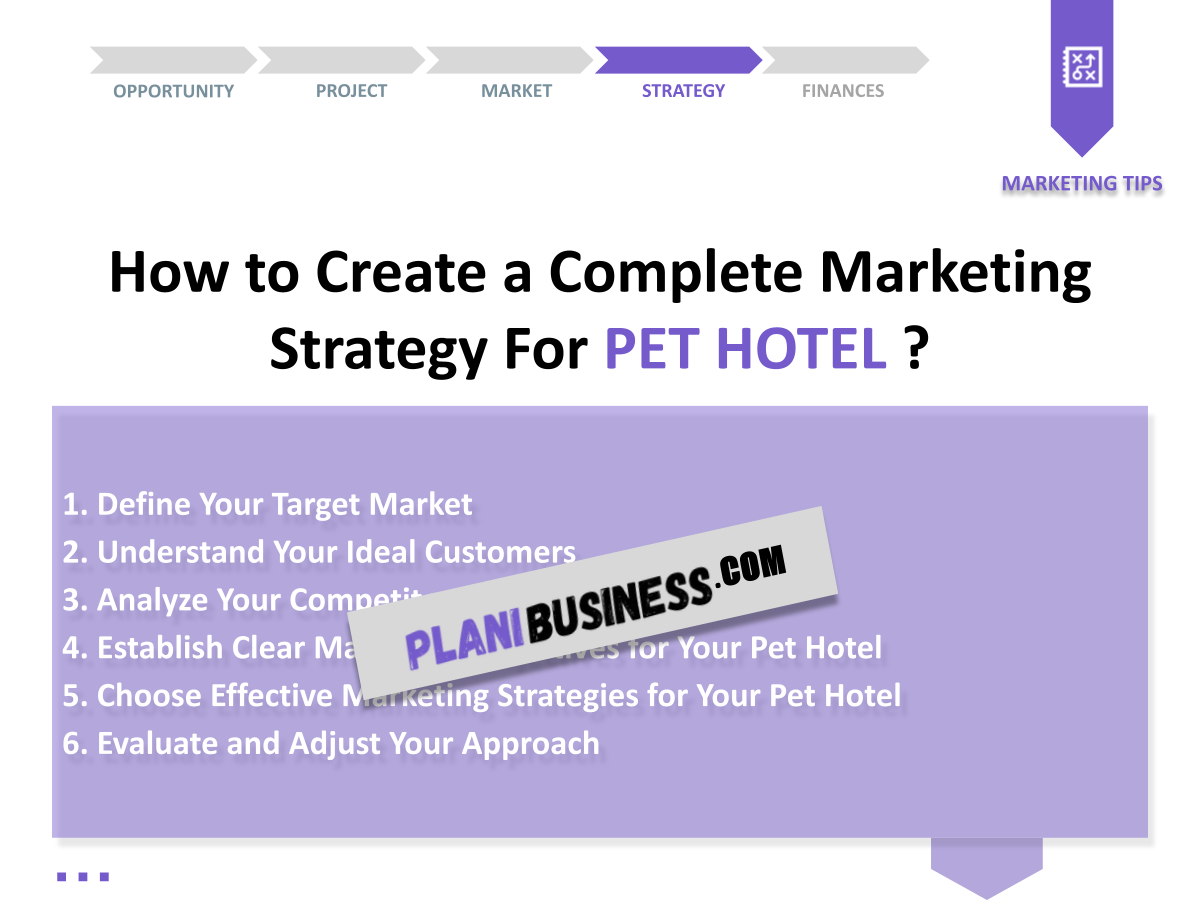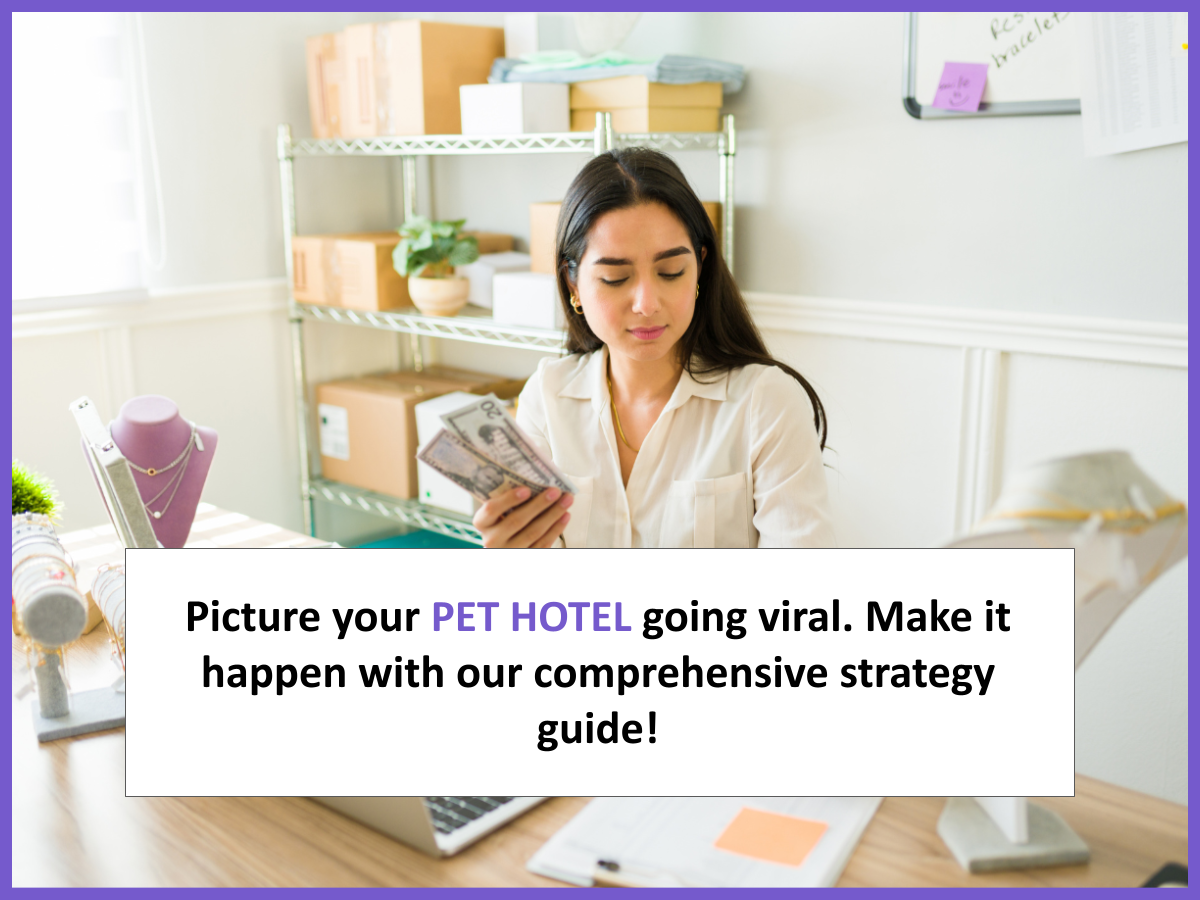Pet Hotel Marketing Plan is essential for any pet hotel owner looking to thrive in the competitive pet care industry. Did you know that the pet care market is projected to grow by over 10% annually? This remarkable trend underscores the importance of having a solid marketing strategy to capture the attention of pet owners. In this article, we’ll explore the necessary steps to create a successful Pet Hotel Marketing Plan that not only attracts new clients but also keeps your furry guests happy and engaged.
1. Define Your Target Market
| Segment | Characteristics | Potential |
|---|---|---|
| Pet Owners | Age, income, location | High demand for services |
| Pet Enthusiasts | Active on social media, loyal customers | Engaged audience for promotions |
Understanding your target market is the first step in your Pet Hotel Marketing Plan. By identifying key demographics, such as age, income, and location, you can tailor your services to meet the specific needs of your audience. For example, if your target market is young professionals, consider offering flexible drop-off and pick-up times, as well as premium services like grooming or training.
- Research demographics: Use surveys or market research to gather data.
- Segment your audience: Create customer profiles based on different characteristics.
- Analyze trends: Look for trends in pet ownership in your area to refine your offerings.
By defining your target market, you can create more effective marketing messages that resonate with potential clients. This focused approach can lead to higher conversion rates and a loyal customer base.
2. Understand Your Ideal Customers
| Customer Type | Needs | Expectations |
|---|---|---|
| Busy Professionals | Convenience, reliability | High-quality care |
| Families | Safety, fun experiences | Trust and communication |
Knowing your ideal customers helps in shaping your marketing messages. For instance, busy professionals may prioritize convenience and reliability, while families might look for safety and engaging experiences for their pets. Tailoring your services and marketing messages to these specific needs can make all the difference in attracting and retaining clients.
To gain a deeper understanding of your ideal customers, consider the following steps:
- Conduct surveys: Gather feedback directly from your current clients to understand their needs.
- Create customer personas: Develop profiles of your ideal customers to guide your marketing efforts.
- Engage with your audience: Use social media and community events to interact with potential clients and learn about their preferences.
By understanding your ideal customers, you can create a more personalized experience that fosters loyalty and encourages repeat business.
3. Analyze Your Competitors
| Competitor | Strengths | Weaknesses |
|---|---|---|
| Local Pet Hotel A | Strong social media presence | High prices |
| Local Pet Hotel B | Affordable rates | Limited services |
Analyzing your competitors is a crucial step in developing your Pet Hotel Marketing Plan. By understanding what others are doing well and where they fall short, you can position your services to fill gaps in the market. For example, if a competitor is known for their high prices, you might offer competitive rates while maintaining quality services.
Here are some effective ways to conduct a competitor analysis:
- Identify key competitors: List out the major pet hotels in your area.
- Evaluate their strengths and weaknesses: Look at their services, pricing, customer reviews, and marketing strategies.
- Monitor their marketing efforts: Follow their social media accounts and subscribe to their newsletters to stay updated on their promotions.
By regularly analyzing your competitors, you can adjust your marketing strategies and service offerings to better meet the needs of your target audience. This not only helps in gaining a competitive edge but also fosters innovation within your business.
4. Establish Clear Marketing Objectives for Your Pet Hotel
| Objective | Measurement | Timeframe |
|---|---|---|
| Increase bookings by 20% | Monthly sales reports | 6 months |
| Boost social media followers by 30% | Follower count | 3 months |
Setting clear marketing objectives is essential for your Pet Hotel Marketing Plan. These objectives provide direction and help measure the success of your marketing efforts. For instance, if you aim to increase bookings by 20% within six months, you can develop specific strategies to achieve this goal.
Consider the following tips when establishing your marketing objectives:
- Be specific: Clearly define what you want to achieve. Instead of saying “increase bookings,” specify the percentage or number.
- Make them measurable: Ensure that you can track your progress using quantifiable metrics.
- Set realistic timeframes: Establish deadlines to create urgency and motivation.
By having clear marketing objectives, you can stay focused on your goals and adjust your strategies as necessary to ensure the growth of your pet hotel business.
5. Choose Effective Marketing Strategies for Your Pet Hotel
| Strategy | Channel | Details |
|---|---|---|
| Social Media Campaigns | Facebook, Instagram | Engaging content and ads |
| Local Partnerships | Pet stores, vets | Cross-promotions |
Choosing the right marketing strategies is crucial for your Pet Hotel Marketing Plan. Effective strategies can help you reach your target audience more efficiently and enhance your brand visibility. For example, utilizing social media platforms like Facebook and Instagram can help you engage with pet owners and showcase your services through eye-catching visuals and promotions.
Here are some effective marketing strategies you can implement:
- Social Media Marketing: Create engaging posts that feature adorable pets, special offers, and testimonials from happy customers.
- Email Marketing: Send out newsletters with updates, promotions, and tips for pet care to keep your audience informed and engaged.
- Local Advertising: Invest in flyers, local magazine ads, or community boards to reach potential customers in your area.
- Referral Programs: Encourage existing clients to refer friends and family by offering discounts or free services for successful referrals.
By selecting the right mix of marketing strategies, you can effectively promote your pet hotel, attract new clients, and build lasting relationships with your customers.
6. Evaluate and Adjust Your Approach
| Evaluation Method | Frequency | Purpose |
|---|---|---|
| Customer Feedback | Monthly | Improve services |
| Sales Data | Quarterly | Measure effectiveness |
Regular evaluation of your marketing efforts is vital for the success of your Pet Hotel Marketing Plan. By monitoring key metrics and gathering customer feedback, you can identify what’s working and what needs improvement. This proactive approach allows you to make data-driven decisions that enhance your marketing strategy.
Here are some methods to effectively evaluate and adjust your marketing approach:
- Gather Customer Feedback: Use surveys, reviews, and social media interactions to collect insights on customer satisfaction.
- Analyze Sales Data: Regularly review your sales reports to identify trends, peak times, and areas for growth.
- Monitor Marketing Campaigns: Track the performance of your marketing campaigns using analytics tools to see which strategies yield the best results.
By continuously evaluating and adjusting your marketing approach, you can ensure that your pet hotel remains competitive and aligned with the needs of your clients.
7. Example N°1 of Marketing Plan for a Pet Hotel
| Steps | Actions | Details |
|---|---|---|
| Target Market | Identify key demographics | Focus on pet owners aged 25-45 |
| Ideal Customers | Survey existing customers | Gather insights on preferences |
| Competitors | Conduct SWOT analysis | Identify strengths and weaknesses |
| Marketing Objectives | Set measurable goals | Increase bookings by 20% |
| Marketing Strategies | Implement social media campaigns | Use engaging visuals |
| Evaluation | Review monthly | Adjust strategies as needed |
This example outlines a straightforward yet effective Pet Hotel Marketing Plan. It focuses on identifying the target market, which includes pet owners aged 25-45, a demographic that often seeks quality care for their pets. By surveying existing customers, the hotel can gather valuable insights that help tailor services to meet their needs.
Setting measurable goals, such as increasing bookings by 20%, provides a clear direction for the marketing efforts. Implementing social media campaigns that feature engaging visuals of happy pets can significantly boost interest and attract new clients. Regular reviews and adjustments ensure that the marketing strategies remain effective and aligned with customer expectations.
8. Example N°2 of Marketing Plan for a Pet Hotel
| Steps | Actions | Details |
|---|---|---|
| Target Market | Focus on urban pet owners | High demand for pet services |
| Ideal Customers | Analyze online behavior | Target tech-savvy individuals |
| Competitors | Benchmark against top hotels | Identify unique selling points |
| Marketing Objectives | Increase online bookings | Target 30% growth |
| Marketing Strategies | Launch email marketing campaigns | Offer discounts for first-time customers |
| Evaluation | Monitor website analytics | Assess traffic and conversion rates |
This second example highlights a marketing plan tailored for urban pet owners, a demographic that often has a high demand for pet services. By analyzing online behavior, the hotel can effectively target tech-savvy individuals who are likely to book services online. The objective of achieving a 30% growth in online bookings can be supported through strategic email marketing campaigns that offer discounts for first-time customers.
Monitoring website analytics will help the hotel assess the effectiveness of its marketing strategies, ensuring they adapt to changing customer behaviors and preferences. This proactive approach not only boosts bookings but also enhances customer satisfaction.
9. Example N°3 of Marketing Plan for a Pet Hotel
| Steps | Actions | Details |
|---|---|---|
| Target Market | Identify pet-friendly neighborhoods | Focus on high-income areas |
| Ideal Customers | Develop customer personas | Understand their motivations |
| Competitors | Evaluate service offerings | Identify gaps in the market |
| Marketing Objectives | Enhance brand visibility | Target local community events |
| Marketing Strategies | Host pet adoption events | Partner with local shelters |
| Evaluation | Collect post-event feedback | Measure community engagement |
This example emphasizes the importance of targeting pet-friendly neighborhoods, especially in high-income areas where pet owners are likely to seek premium services. By developing detailed customer personas, the pet hotel can tailor its marketing messages to resonate with potential clients’ motivations and needs.
Enhancing brand visibility through participation in local community events, such as hosting pet adoption drives, can significantly increase awareness and goodwill. Partnering with local shelters not only helps the community but also positions the hotel as a caring and responsible business. Collecting feedback after these events will allow for measuring engagement and refining future marketing efforts.
10. Example N°4 of Marketing Plan for a Pet Hotel
| Steps | Actions | Details |
|---|---|---|
| Target Market | Analyze pet ownership trends | Focus on increasing dog owners |
| Ideal Customers | Conduct focus groups | Gather insights on preferences |
| Competitors | Identify top competitors | Assess their marketing tactics |
| Marketing Objectives | Improve customer retention | Implement loyalty programs |
| Marketing Strategies | Utilize referral programs | Encourage word-of-mouth marketing |
| Evaluation | Track customer loyalty metrics | Assess program effectiveness |
This fourth example focuses on analyzing pet ownership trends, particularly the increasing number of dog owners. By conducting focus groups, the hotel can gather valuable insights into what dog owners look for in a pet hotel, enabling the business to tailor its offerings accordingly.
Improving customer retention is a key objective, which can be achieved through implementing loyalty programs that reward repeat customers. Additionally, utilizing referral programs encourages satisfied clients to share their positive experiences, thus driving new business through word-of-mouth marketing. Tracking customer loyalty metrics will help evaluate the effectiveness of these initiatives, ensuring they align with the hotel’s overall marketing goals.
11. Example N°5 of Marketing Plan for a Pet Hotel
| Steps | Actions | Details |
|---|---|---|
| Target Market | Research local pet demographics | Understand pet ownership rates |
| Ideal Customers | Survey potential clients | Gather insights on needs |
| Competitors | Analyze pricing strategies | Find competitive advantages |
| Marketing Objectives | Establish brand authority | Publish valuable content |
| Marketing Strategies | Create a blog | Share tips on pet care |
| Evaluation | Monitor blog traffic | Assess engagement and reach |
This example emphasizes the importance of researching local pet demographics to understand pet ownership rates. By surveying potential clients, the pet hotel can gather insights into what pet owners are looking for, which helps tailor services accordingly.
Establishing brand authority is a key marketing objective, which can be achieved by publishing valuable content that resonates with pet owners. Creating a blog that shares tips on pet care not only positions the hotel as an expert in the field but also helps attract organic traffic from search engines. Monitoring blog traffic will allow the hotel to assess engagement levels and adjust content strategies as needed.
12. Example N°6 of Marketing Plan for a Pet Hotel
| Steps | Actions | Details |
|---|---|---|
| Target Market | Identify target income groups | Focus on middle to high-income families |
| Ideal Customers | Analyze customer preferences | Understand service needs |
| Competitors | Conduct market research | Identify unique features |
| Marketing Objectives | Increase service awareness | Host community events |
| Marketing Strategies | Engage with local influencers | Promote through social channels |
| Evaluation | Review event outcomes | Assess community response |
This sixth example focuses on identifying target income groups, particularly middle to high-income families who are more likely to seek premium pet services. Analyzing customer preferences helps the hotel understand what services are in demand, enabling them to tailor their offerings accordingly.
Increasing service awareness is a primary objective that can be accomplished by hosting community events. Engaging with local influencers can amplify the hotel’s reach and credibility, allowing them to promote the hotel through social channels. Reviewing the outcomes of these events will help assess community response and refine future marketing strategies.
13. Example N°7 of Marketing Plan for a Pet Hotel
| Steps | Actions | Details |
|---|---|---|
| Target Market | Focus on pet-loving communities | Identify high engagement areas |
| Ideal Customers | Utilize demographic data | Tailor services to local needs |
| Competitors | Review competitor offerings | Spot gaps in services |
| Marketing Objectives | Enhance service visibility | Utilize local SEO strategies |
| Marketing Strategies | Optimize Google My Business | Encourage customer reviews |
| Evaluation | Track website traffic | Assess effectiveness of SEO efforts |
This final example highlights the importance of focusing on pet-loving communities and identifying areas with high engagement potential. Utilizing demographic data allows the hotel to tailor its services to meet local needs effectively.
Enhancing service visibility is crucial, which can be achieved through local SEO strategies. Optimizing Google My Business is essential for attracting local traffic, while encouraging customer reviews can enhance credibility and trust. By tracking website traffic, the hotel can assess the effectiveness of its SEO efforts and make necessary adjustments to improve visibility and reach.
Conclusion
In conclusion, creating a successful Pet Hotel Marketing Plan involves understanding your target market, analyzing competitors, setting clear objectives, and implementing effective marketing strategies. By following the outlined examples and continually evaluating your approach, you can attract more clients and ensure the satisfaction of your furry guests. To further enhance your business planning, consider checking out this great business plan template for Pet Hotel, which provides a solid foundation for your marketing efforts.
Additionally, if you’re looking for more insights, don’t miss our articles on How to Kickstart a Pet Hotel? and How to Create a SWOT Analysis for Pet Hotel. These resources will equip you with valuable knowledge to successfully launch and manage your pet hotel business.
FAQ
- What is a Pet Hotel Marketing Plan?
A Pet Hotel Marketing Plan is a strategic outline that helps pet hotels attract customers, define their target market, and implement marketing strategies to grow their business. - How can I attract customers to my pet hotel?
You can attract customers by utilizing social media marketing, engaging with local communities, hosting events, and offering promotions to first-time clients. - What marketing strategies are effective for pet hotels?
Effective strategies include social media campaigns, email marketing, local advertising, referral programs, and partnerships with local businesses. - How do I define my target market for a pet hotel?
Defining your target market involves researching demographics such as age, income, and pet ownership trends to tailor your services accordingly. - What should be included in a pet hotel marketing plan?
A comprehensive marketing plan should include a target market analysis, competitor analysis, marketing objectives, strategies, and evaluation methods. - How can I improve customer retention in my pet hotel?
Improving customer retention can be achieved through loyalty programs, personalized services, and regular communication with clients to keep them engaged. - What are the common challenges in pet hotel marketing?
Common challenges include high competition, changing customer preferences, and effectively communicating your unique selling points. - How often should I evaluate my marketing strategies?
It’s advisable to evaluate your marketing strategies regularly, at least quarterly, to ensure they are effective and aligned with your business goals. - Can social media help in marketing my pet hotel?
Yes, social media is a powerful tool for marketing your pet hotel, allowing you to engage with potential customers, showcase your services, and share customer testimonials. - How do I create a strong online presence for my pet hotel?
Creating a strong online presence involves optimizing your website for search engines, utilizing social media platforms, and engaging with customers through blogs and newsletters.







